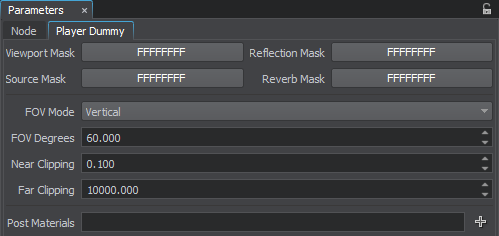Player Dummy
A dummy player is a simple viewport into the world that has no physical properties and cannot collide with objects.
See also
- A PlayerDummy class to edit dummy players via API
Notice
As any transformation of a player forces it to recalculate its inner state (position, direction, angles and so on), the up direction of the player's viewport may become "negative forward". And then transformation will be recalculated by using this direction, causing flip of the player's basis. To avoid such flipping, the theta and phi angles should be recalculated by using the current viewing orientation of the player.
Creating a Dummy Player
To create a dummy player, do the following:
- On the Menu bar, choose Create -> Player -> Dummy.

- Place the camera somewhere in the world and specify the required parameters via the Parameters window.
Editing a Dummy Player
In the Player Dummy tab, you can adjust the bit-masks and viewing frustum parameters of the dummy player.

Vertical Player Parameters

Physically-Based Player Parameters
Post-processed Materials
In the Materials parameter field you can add post-processed materials to the camera. They will be applied after all other post-processes (such as HDR, DOF, etc.) are applied.

The Materials parameter
Add a post-processed material from the dialog window appeared to the materials list by using the  .
.
Last update: 2018-08-10
Help improve this article
Was this article helpful?
(or select a word/phrase and press Ctrl+Enter)